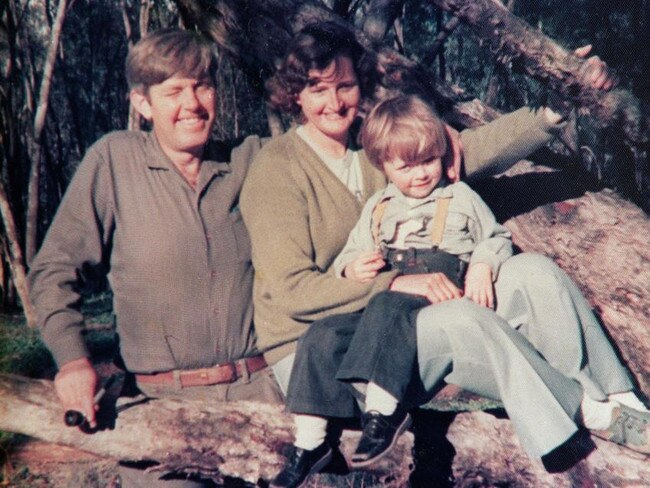Hitman’s death frees secret witness to reveal where anti-drug campaigner’s remains are
A SECRET witness can now reveal where anti-drug campaigner Donald Mackay’s remains were disposed, after mafia hitman James Bazley’s death. And the explosive details could lead to murder charges against the mafia bosses who ordered it.
Breaking news
Don't miss out on the headlines from Breaking news. Followed categories will be added to My News.
THE death of mafia hitman James Bazley will spark a new search for the body of Griffith anti-drug campaigner Donald Mackay based on the evidence of a secret new witness.
Bazley told a trusted associate where he disposed of Mr Mackay’s body but swore that associate to secrecy until after his death.
Now Bazley is dead that associate is expected to keep his promise and reveal to police what Bazley did with Mackay’s body.
JAMES BAZLEY DIES, SILENT TO THE END
HOW MAFIA BOSSES ORDERED DONALD MACKAY’S DEATH
That explosive new information about the 1977 execution of anti-drug campaigner Donald Mackay could lead to murder charges against the Calabrian mafia bosses who ordered it.
It is also expected to prompt another search for Mr Mackay’s remains.
The Herald Sun has been told Bazley’s death will lead to detectives being told where and how the hitman claimed he disposed of the body just over 40 years ago.
If police find the body it could provide enough new evidence to charge at least one major Mafioso with the Mackay murder.
Bazley’s recent death at the age of 92 has freed his associate to claim to police that Bazley confessed to him that he murdered Mr Mackay and revealed details of how he got rid of the body.


Police are expected to search the area where Bazley claimed to have disposed of Mr Mackay’s body.
Bazley executed Mr Mackay, 43, in Griffith, New South Wales on July 15, 1977.
The murder of the Liberal Party candidate and anti-drug crusader was Australia’s first political assassination.
His body has never been found and the Calabrian mafia bosses who ordered his death have never been charged.
Police have evidence that four people held a board meeting of the Griffith Calabrian mafia in May 1977 and branded Mr Mackay a troublemaker who had to be killed.
One of them, Griffith winery boss Tony Sergi, died in October last year; another lives a life of crime in Victoria and the other two, Robert Trimbole and Gianfranco Tizzoni, are dead. Trimbole fled Australia and died in Spain in 1987 and Tizzoni died in Italy in 1988.



Other Griffith mobsters were also involved in the plot to murder Mackay because his anti-drugs stance was seriously affecting their illegal business.
Before his death he was publicly campaigning against the Calabrian mafia’s rampant drug dealing — and was naming names.
The now retired Victoria Police detective whose taskforce cracked the Mackay case hopes NSW police will be able to lay several murder charges if Mr Mackay’s body is found.
“This might include those responsible for ordering and arranging Mr Mackay’s death,” former deputy commissioner Carl Mengler told the Herald Sun at the time of a failed search for Mr Mackay’s body in 2013.
“A prima facie case exists against a number of persons. Much evidence has been gathered both in Victoria and NSW over the many years since.”
It was revealed in the Herald Sun in 2014 that Griffith detectives had made a secretive visit to Victoria to chase up new leads in the Mackay murder.
The new information that prompted Supt Mick Rowan and Det Insp Paul Smith to come to Victoria to investigate was provided after a failed dig to find Mr Mackay’s body in 2013.
Police spent two weeks excavating a property near Hay, NSW, in June 2013 after receiving information anonymously that Mr Mackay’s body was buried there.
While the dig failed to find any trace of the body, publicity about it led to new information being provided to police.

Victoria Police Det-Insp Ken Ashworth confirmed to the Herald Sun in 2014 that the Purana anti-gang taskforce was assisting Griffith detectives with information relating to underworld identities suspected of having knowledge of, or involvement in, what is one of Australia’s oldest murder mysteries.
He said he provided the Griffith detectives with access to documents and other material Victoria Police has on the high-profile killing of Mr Mackay.
Supt Rowan told the Herald Sun that, while the new probe into the Mackay killing was primarily to find the body, he was not ruling out one day laying murder charges over the Mackay murder.
“If you found a body you may also find other things that could certainly be cause for further investigation,” he said.
“The investigative techniques and so forth have advanced so far over the intervening period that you would never say never.”
The new information given to Griffith detectives in 2014 strongly suggested Melbourne-based criminal Gianfranco Tizzoni was with Bazley when Mr Mackay was shot dead.
The Griffith detectives believe Tizzoni and Bazley put a lot of work into planning to murder Mr Mackay near Jerilderie, NSW, on July 12, 1977.
Furniture shop owner Mr Mackay had been tricked into meeting Bazley, who was posing as a potential customer, at Jerilderie that day, but ended up not going due to having to unexpectedly attend a funeral.

It is likely Tizzoni, who died of natural causes in 1988, and Bazley had planned the Jerilderie hit in such a way they were unlikely to be seen or heard.
A number of high-profile Calabrian mafia identities — who each would have been prime suspects — had alibis for the day of the planned Jerilderie murder of Mr Mackay that took them away from Griffith.
The Griffith detectives believe the actual hit three days later on July 15 was rushed and ill-planned because Tizzoni and Bazley were ordered by the Calabrian mafia bosses to do it quickly while their alibis were still strong and available to them.
That meant shooting Mr Mackay in a pub car park in Griffith about 6.30 on a Friday night. Shells left behind were later linked to a gun owned by Bazley.
One of the three .22 spent cartridges found at the murder scene had blood, tissue and hair on it, later identified as coming from Mr Mackay.

Mr Mackay was a big man. Shooting him dead in a busy pub car park and then presumably lifting his body into a car boot without anyone seeing would be incredibly difficult for one man.
Tizzoni is the most likely person to have helped Bazley at the murder scene.
“I have reviewed the full NSW brief of evidence, and also material held by Victoria Police, and it is my view that it was highly likely to have been two people involved,” Supt Rowan told the Herald Sun in 2014.
“I wouldn’t discount that Tizzoni was at Jerilderie and it may well be he was at Griffith.”
While Bazley and Tizzoni were charged years later by Victoria Police with conspiring to murder Mr Mackay, nobody has ever been charged with murdering him.
The Calabrian mafia’s Mr Fix-it, Robert Trimbole, was told to organise the hit on Mr Mackay and he enlisted Tizzoni’s help.

Tizzoni used his underworld contacts to hire Bazley, a former painter and docker union heavy.
Bazley was chosen because the Calabrians didn’t want the Mackay killing to look like a mafia hit.
The Griffith detectives paid Bazley a visit at his Melbourne home in 2014.
“We approached Mr Bazley, who was not willing to discuss the matter further with NSW or Victoria Police,” Insp Smith said then.
“He made it very clear he didn’t want to talk to police, both in person and through his lawyer.”
Bazley was released from Victoria’s Loddon Prison in 2001 after serving 21 years in jail — only nine of them relating to his conviction for conspiring to murder Mr Mackay.
While the evidence led at Bazley’s trail in Melbourne was that he shot dead Mr Mackay he couldn’t be charged with murder in Victoria because the crime took place in NSW.

He was charged in Victoria as it was Victorian detectives who obtained the evidence against him in relation to the conspiracy to murder Mr Mackay and the 1979 murders of Mr Asia drug couriers Douglas and Isabel Wilson, whose bodies were discovered in a bush grave at Rye.
Bazley pleaded not guilty to the charges over the Wilsons and Mr Mackay and continued to maintain his innocence up to his recent death.
The Herald Sun can also reveal Mr Mackay’s widow, Barbara, tried to get into prison to beg Bazley to tell her where her husband’s body was.
She planned to give Bazley her word she would never reveal where she got the information.
Her plan to visit Bazley failed as it proved too difficult to arrange, but she did manage to smuggle a letter to Bazley in jail.
Despite her telling Bazley in the letter that she had forgiven him, he told her in his written reply that he couldn’t help because he didn’t commit the murder and didn’t know where the body was.

Mrs Mackay, who died in 2001 at age 65, just weeks after Bazley was paroled, made the unusual move to secretly contact Bazley because she was haunted by her husband’s body still being missing.
Mr Mackay’s son Paul played an important role in convincing police to keep probing the killing.
The Herald Sun has seen a copy of a letter Paul Mackay wrote to NSW police chief Andrew Scipione in 2007, in which he requested a full review by the state’s cold case unit.
“None of the (alleged) Griffith conspirators identified in the Woodward Royal Commission have ever been charged,” his letter said.
Several of those named by the commission still lived in Griffith and had prospered to an abnormal degree.
“The opinion of most Griffith residents is that these people literally can get away with murder and, to date, they effectively have,” Mr Mackay wrote.
“Our family has received little justice and believes that this case remains unsolved.”
A $200,000 reward is available for information which leads to the finding of Mr Mackay’s body.


